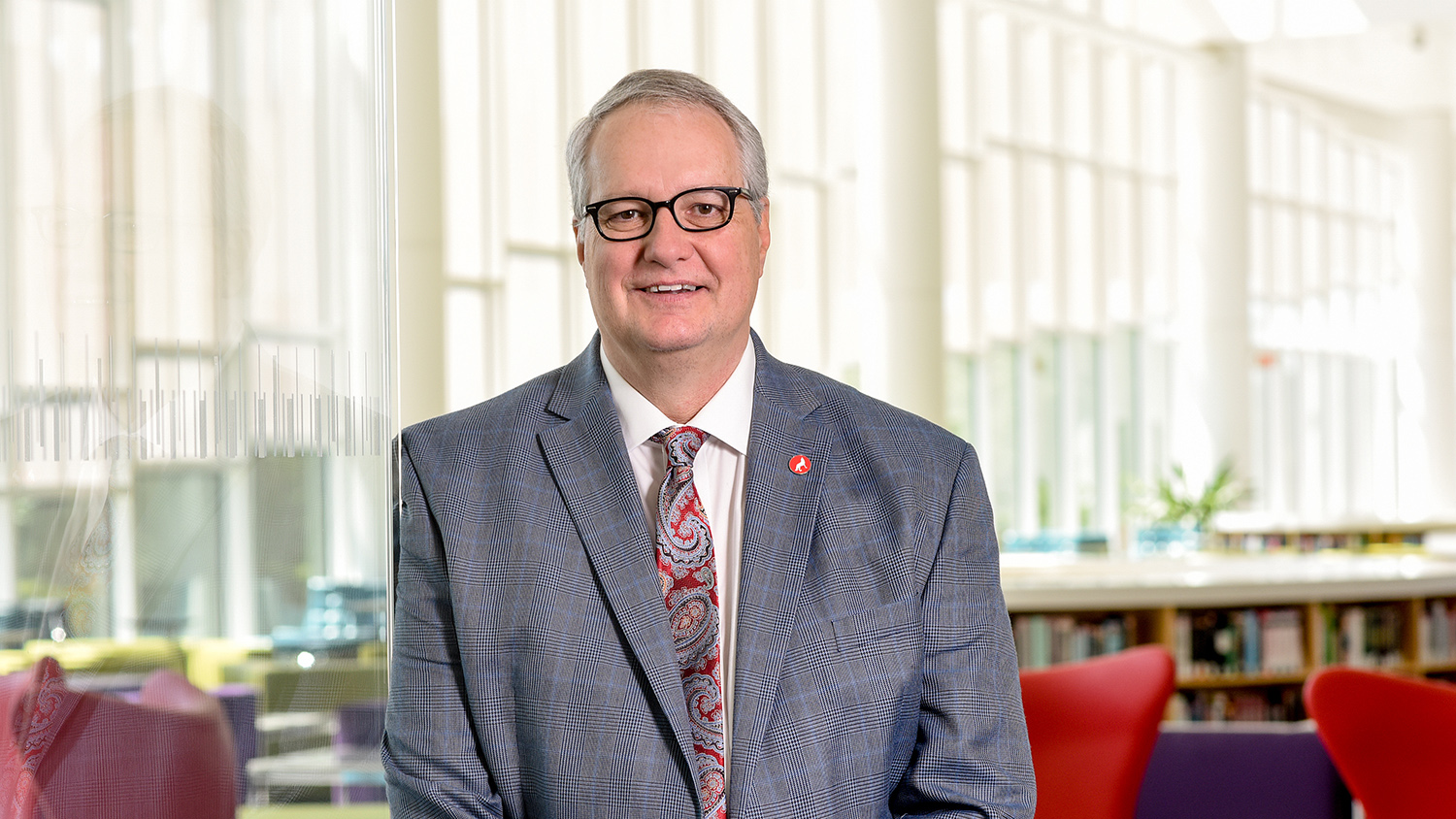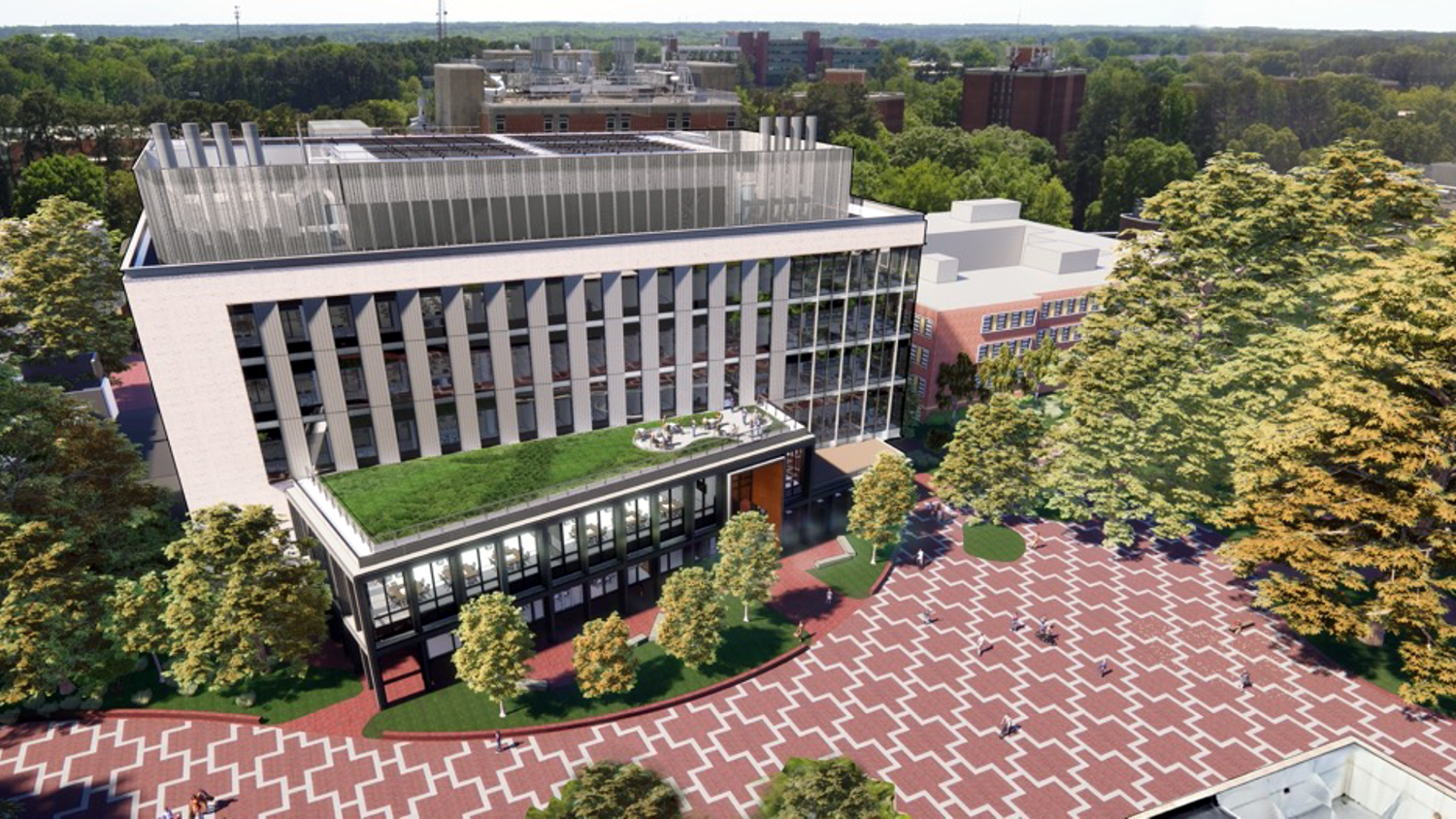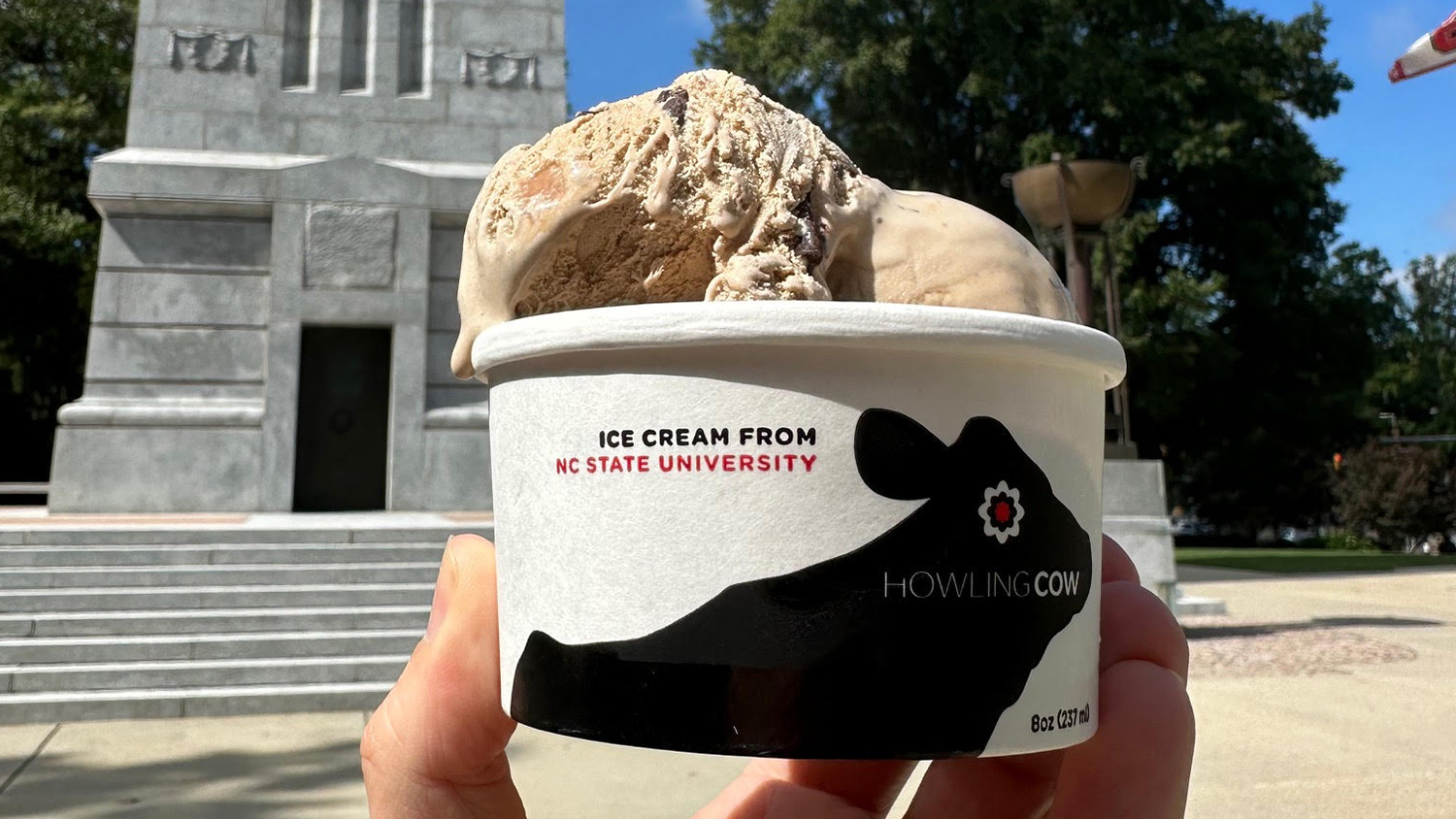NC State Summer Fun
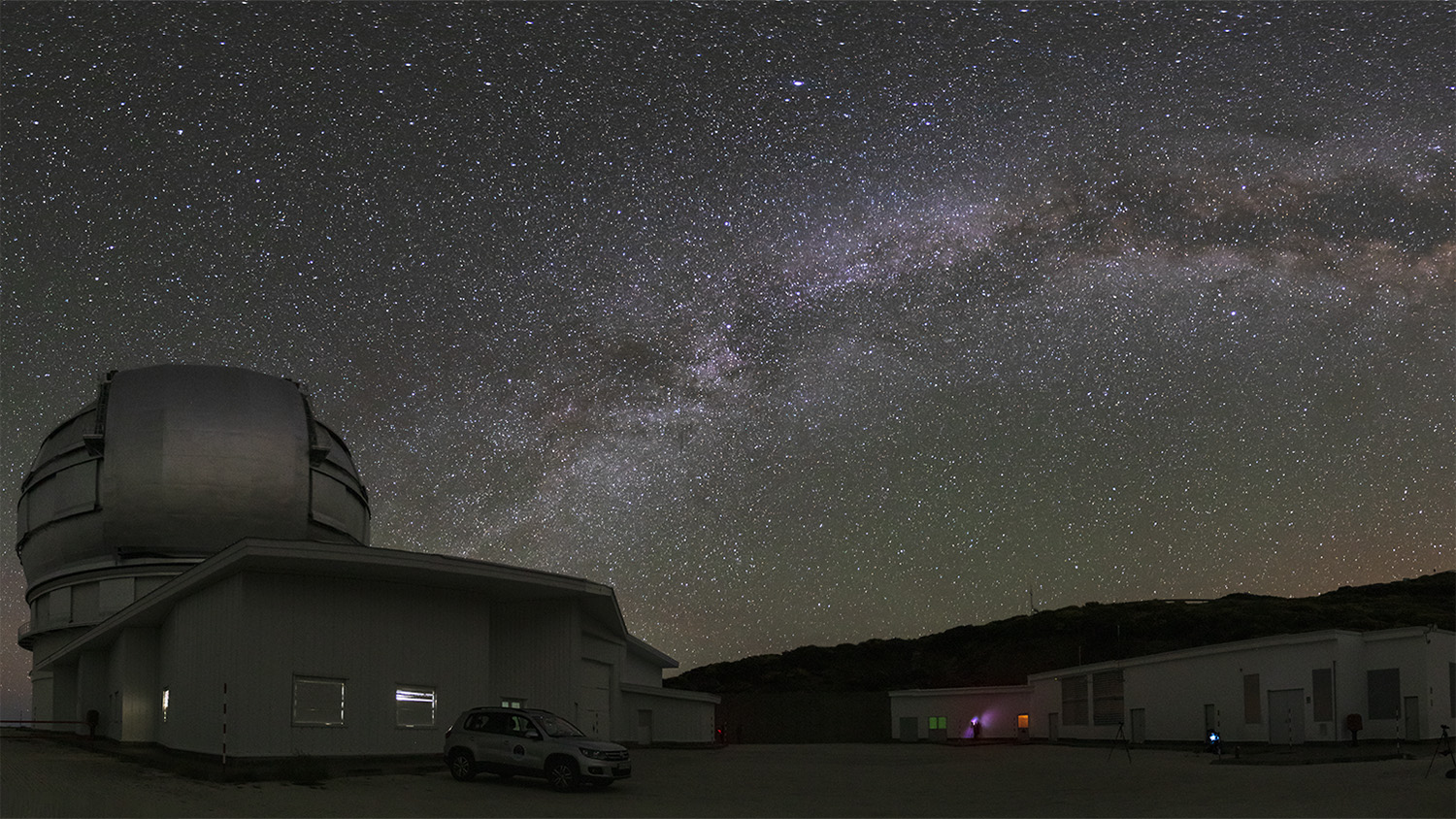
NC State faculty, staff and students spent their summer taking the Think and Do spirit across the country and around the world. Whether teaching, researching, serving or just having summer fun, the Wolfpack made the most of the past few months. Here are their stories.
CHASS Faculty and Staff
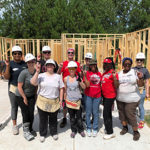 Faculty and staff from the College of Humanities and Social Sciences spent a day this summer helping build a Habitat for Humanity home in Southeast Raleigh. This is the third year that the college has participated in a Habitat for Humanity build. After this year’s workday, the team visited NC State and CHASS alumna Maggie Kane at her pay-what-you-can restaurant, A Place at the Table, in downtown Raleigh.
Faculty and staff from the College of Humanities and Social Sciences spent a day this summer helping build a Habitat for Humanity home in Southeast Raleigh. This is the third year that the college has participated in a Habitat for Humanity build. After this year’s workday, the team visited NC State and CHASS alumna Maggie Kane at her pay-what-you-can restaurant, A Place at the Table, in downtown Raleigh.
Global Training Initiative Staff and Students
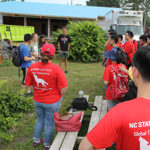 The Global Training Initiative (GTI) team had a busy summer traversing the state from Cherokee to Carolina Beach with more than 300 participants in 14 of our summer programs. The GTI expanded its summer programming this year for overseas and NC State students to include various academic and special topic programs, research and internship experiences, global skills and leadership training, as well as faculty training. Read more about our busiest summer ever.
The Global Training Initiative (GTI) team had a busy summer traversing the state from Cherokee to Carolina Beach with more than 300 participants in 14 of our summer programs. The GTI expanded its summer programming this year for overseas and NC State students to include various academic and special topic programs, research and internship experiences, global skills and leadership training, as well as faculty training. Read more about our busiest summer ever.
Jennifer Fawcett
Extension Associate
Department of Forestry and Environmental Resources, College of Natural Resources/NC State Extension
Laurel Kays
Extension Assistant
Department of Forestry and Environmental Resources, College of Natural Resources/NC State Extension
Colby Lambert
Area Specialized Agent, Forestry
Department of Forestry and Environmental Resources, College of Natural Resources/NC State Extension
Mark Megalos
Extension Professor
Department of Forestry and Environmental Resources, College of Natural Resources/NC State Extension
Renee Strnad
Environmental Educator
Department of Forestry and Environmental Resources, College of Natural Resources/NC State Extension
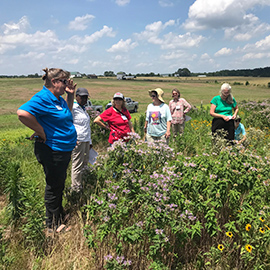
This summer, we had several outreach efforts focusing on pollinators supported through Renewable Resources Extension Act funding from the USDA National Institute of Food and Agriculture. With that funding, a group of us in Extension Forestry hosted two workshops for women landowners on managing for pollinators and native species. One was held in Waynesville, and the other was held in Louisburg, North Carolina. Both included a morning classroom portion that included talks on the importance of pollinators, how to manage for pollinators and native species, invasive plant management and removal, and incentive programs. Both workshops included field tours to see pollinator and native plant management in action.
We also hosted a program earlier in June on women’s chainsaw safety (with the same funding source but a slightly different and multi-agency organizing team), which included the chance for women to use a chainsaw under the supervision of a professional. These three programs, and some others in the state we are involved with (such as the ForestHER network programs-) are part of a larger effort to reach women landowners who often do not attend or feel welcome at typically male-dominated traditional outreach programs. We hope not only to reach them through our workshops, but to help them create community and networks with each other. We set up a Google Group for program attendees to help them keep in touch following the workshops as part of that goal, and we are hoping to plan more programs like this in the future.
With regards to the team that worked on these in Extension Forestry, everyone listed above, as well as Jill Sidebottom, worked on the pollinator programs. Jenn Fawcett and Laurel Kays worked on the chainsaw workshop along with Liz Snider (who was an instructor and helped us plan) and folks from outside NC State.
Peter Askim
Director of Orchestral Studies
Department of Music, Division of Academic and Student Affairs
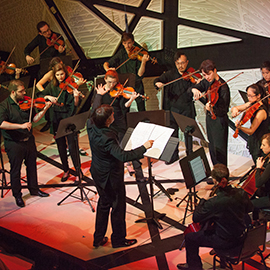 This summer, I led the seventh season of the summer music program I founded, The Next Festival of Emerging Artists. Designed to provide early-career performers, composers and choreographers with real-world experience and support for their careers, the festival combines performance opportunities, artistic mentorship and entrepreneurial strategies for success in a changing artistic landscape. The program is focused on contemporary music and presents numerous new works and world premieres, in close consultation with the composers themselves. This summer, the Next Festival continued its innovative workshops for young composers and choreographers and was in residence at the NYU Center for Ballet in the Arts. The musicians performed the works of living composers at the cutting edge New York City venue National Sawdust (pictured). The festival received grants from the American Society of Composers, Authors and Publishers, the Aaron Copland Fund for Music and the Amphion Foundation, among others.
This summer, I led the seventh season of the summer music program I founded, The Next Festival of Emerging Artists. Designed to provide early-career performers, composers and choreographers with real-world experience and support for their careers, the festival combines performance opportunities, artistic mentorship and entrepreneurial strategies for success in a changing artistic landscape. The program is focused on contemporary music and presents numerous new works and world premieres, in close consultation with the composers themselves. This summer, the Next Festival continued its innovative workshops for young composers and choreographers and was in residence at the NYU Center for Ballet in the Arts. The musicians performed the works of living composers at the cutting edge New York City venue National Sawdust (pictured). The festival received grants from the American Society of Composers, Authors and Publishers, the Aaron Copland Fund for Music and the Amphion Foundation, among others.
Additionally, my compositions were featured in an evening-length work of choreography presented by the LA Dance Festival in Los Angeles and at the Seoul International Dance Festival. I have spent the balance of the summer composing three newly commissioned works.
The Next Festival of Emerging Artists Website: www.next-fest.org
Next Festival Performance videos: http://next-fest.org/videos/
Rachel Atkins
Ph.D. Student
Department of Marine, Earth and Atmospheric Sciences, College of Sciences
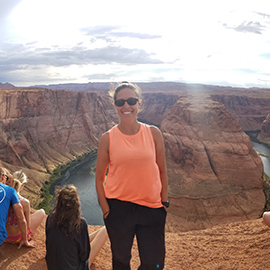 This summer, I had the privilege of teaching an introductory geology field course for incoming freshman alongside Dr. Karl Wegmann (MEAS) and Chester Brewer (University Scholars Program). We led students on a two-week “GeoJourney” along the Colorado River from Denver to Las Vegas, learning about geologic processes and geo-environmental issues along the way. We had a great time exploring geology up close and all learned substantially about core geology curricula such as plate tectonic theory, mineral and rock identification, paleoenvironmental reconstruction and geomorphic evolution of landscapes.
This summer, I had the privilege of teaching an introductory geology field course for incoming freshman alongside Dr. Karl Wegmann (MEAS) and Chester Brewer (University Scholars Program). We led students on a two-week “GeoJourney” along the Colorado River from Denver to Las Vegas, learning about geologic processes and geo-environmental issues along the way. We had a great time exploring geology up close and all learned substantially about core geology curricula such as plate tectonic theory, mineral and rock identification, paleoenvironmental reconstruction and geomorphic evolution of landscapes.
Gary Blank
Associate and Alumni Distinguished Undergraduate Professor
Department of Forestry and Environmental Resources, College of Natural Resources
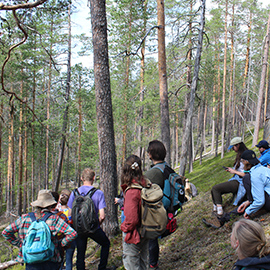 Nine NC State students, Nichole Howe and I joined ten Purdue students, five Swedish students, along with faculty from both Purdue and SLU (Swedish University of Agricultural Sciences) studying sustainability questions from Umea to Ammarnas in Vasterbotten County, Sweden. Much of this excursion occurred in the Vindelälven Juhtadakka Biosphere Reserve, being dedicated by the European Union on August 19. For me, this was a return to sites along the Vindeln River visited with a study abroad class 18 years ago. Hiking along eskers, visiting forest and river restoration projects, examining bogs and fens, and visiting Sami reindeer herders are all part of exploring boreal ecosystems and interacting with the folks managing and studying those ecosystems. The NR 350 class travels every summer to investigate sustainability concepts and practices as people think about and do them.
Nine NC State students, Nichole Howe and I joined ten Purdue students, five Swedish students, along with faculty from both Purdue and SLU (Swedish University of Agricultural Sciences) studying sustainability questions from Umea to Ammarnas in Vasterbotten County, Sweden. Much of this excursion occurred in the Vindelälven Juhtadakka Biosphere Reserve, being dedicated by the European Union on August 19. For me, this was a return to sites along the Vindeln River visited with a study abroad class 18 years ago. Hiking along eskers, visiting forest and river restoration projects, examining bogs and fens, and visiting Sami reindeer herders are all part of exploring boreal ecosystems and interacting with the folks managing and studying those ecosystems. The NR 350 class travels every summer to investigate sustainability concepts and practices as people think about and do them.
Matthew Booker
Associate Professor
Department of History, College of Humanities and Social Sciences
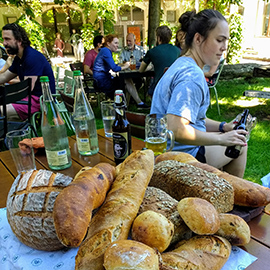 As a fellow at the Rachel Carson Center for the environmental humanities in Munich, Germany, I researched and wrote chapters for my book project on food in industrial cities of the 19th century. I also collaborated with NC State applied ecologists Rob Dunn, a guest speaker at the Carson Center, and Dr. Erin McKenney on a citizen science sourdough experiment incorporating the staff, fellows and students at the center. Using Dr. McKenney’s protocol, we raised sourdough starters, baked bread, and compared the flavor differences caused by the bacteria and yeasts in our kitchens and on our hands. Historians, literature professors, and philosophers got to participate in a global sourdough experiment. My description of the experience will appear in the “Seeing the Woods” blog later this year. This photo is of a Rachel Carson Center field trip to the Herrmannsdorfer farm, butchery, cheesery, brewery, and bakery in Bavaria.
As a fellow at the Rachel Carson Center for the environmental humanities in Munich, Germany, I researched and wrote chapters for my book project on food in industrial cities of the 19th century. I also collaborated with NC State applied ecologists Rob Dunn, a guest speaker at the Carson Center, and Dr. Erin McKenney on a citizen science sourdough experiment incorporating the staff, fellows and students at the center. Using Dr. McKenney’s protocol, we raised sourdough starters, baked bread, and compared the flavor differences caused by the bacteria and yeasts in our kitchens and on our hands. Historians, literature professors, and philosophers got to participate in a global sourdough experiment. My description of the experience will appear in the “Seeing the Woods” blog later this year. This photo is of a Rachel Carson Center field trip to the Herrmannsdorfer farm, butchery, cheesery, brewery, and bakery in Bavaria.
Angela Brockelsby
Associate Vice Provost
Enrollment Management and Services
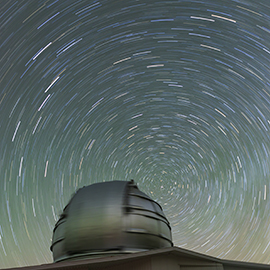 This past May, I attended an astrophotography workshop led by National Geographic photographer Babak Tafreshi in La Palma in the Canary Islands. La Palma is known for one of the darkest skies in the world and is home to the Observatorio del Roque de Los Muchachos and the Instituto de Astrofísica de Canarias. I spent a week learning about the night sky and how to capture it through photography. The photo is a single exposure photo (20 minutes) of the Gran Telescopio Canarias (GTC) — currently the largest single mirror telescope in the world — and the night sky to create a star trail (created from the motion of the stars due to the earth’s rotation). The GTC was in use throughout the night hence the motion blur as astrophysicists conducted research.
This past May, I attended an astrophotography workshop led by National Geographic photographer Babak Tafreshi in La Palma in the Canary Islands. La Palma is known for one of the darkest skies in the world and is home to the Observatorio del Roque de Los Muchachos and the Instituto de Astrofísica de Canarias. I spent a week learning about the night sky and how to capture it through photography. The photo is a single exposure photo (20 minutes) of the Gran Telescopio Canarias (GTC) — currently the largest single mirror telescope in the world — and the night sky to create a star trail (created from the motion of the stars due to the earth’s rotation). The GTC was in use throughout the night hence the motion blur as astrophysicists conducted research.
Berkeley Bryant
Social Media Specialist
College of Natural Resources, University Communications
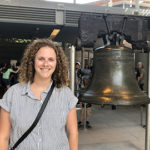 This summer, I won a ticket to the eduWeb2019 conference for higher education marketing and communications in Philadelphia. I was able to travel around Philly before the conference and I visited Independence Hall, the Liberty Bell, and the Reading Terminal Market. I had a blast and it was the best conference I’ve been to!
This summer, I won a ticket to the eduWeb2019 conference for higher education marketing and communications in Philadelphia. I was able to travel around Philly before the conference and I visited Independence Hall, the Liberty Bell, and the Reading Terminal Market. I had a blast and it was the best conference I’ve been to!
Michael Bustle
Associate Vice Provost
Global Training Initiative, Office of Global Engagement
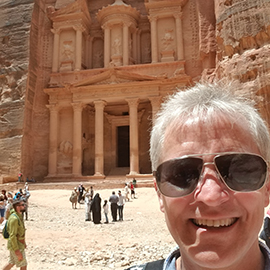 Summer is a busy and productive time for collaboration, partnership and preparation for units in Global Engagement — and the Global Training Initiative is no exception. Not only do we host a dozen noncredit programs each summer in partnership with academic departments to introduce our campus and programs to several hundred visiting international students, but we also engage in various programs and events overseas to promote faculty collaboration, student mobility, and student recruitment.
Summer is a busy and productive time for collaboration, partnership and preparation for units in Global Engagement — and the Global Training Initiative is no exception. Not only do we host a dozen noncredit programs each summer in partnership with academic departments to introduce our campus and programs to several hundred visiting international students, but we also engage in various programs and events overseas to promote faculty collaboration, student mobility, and student recruitment.
This summer, I facilitated a country-wide workshop and training session for the senior leadership (presidents, senior research officers, and senior international officers) at the top dozen universities in Jordan. NC State was among a few universities (including Virginia Tech, and the Universities of Arizona, Florida and Wisconsin) that were represented at the workshop (held on the University of Jordan campus in Amman) that focused on grant-writing and how overseas universities can partner with U.S. universities on research collaboration and student mobility. This workshop created a lot of positive exposure for NC State as well as provide an opportunity to introduce our program strengths, create an avenue and new network for faculty collaboration, initiate graduate student research exchange, and provide access to new research funding. Targeting selective institutions in countries with independent funding sources, highly trained and engaged researchers, with a high level of research capacity, and qualified students who could be competitive graduate applicants for our programs is one of the strategies we employ to build international bridges, networks and opportunities for our faculty and students.
NC State has several partners and programs with Jordanian institutions already including nuclear engineering, summer Arabic language program, and global health, among others. Travel to and within Jordan is convenient and safe plus many people speak English. Visas are not an issue and there are hundreds of millions of dollars in research opportunities. Students and faculty traveling to Jordan have to visit Petra and Wadi Rum.
Eric C. Chi
Assistant Professor
Department of Statistics, College of Sciences
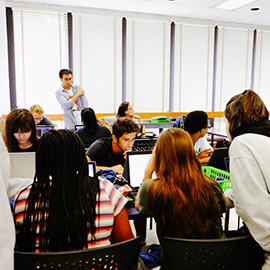 Ana-Maria Staicu and I are co-leading a year-long Data Scientists in Training Program (DST) at NC State. The DST is a community outreach program that is funded through the National Science Foundation and designed to introduce local high school students and teachers to careers and research in data science.
Ana-Maria Staicu and I are co-leading a year-long Data Scientists in Training Program (DST) at NC State. The DST is a community outreach program that is funded through the National Science Foundation and designed to introduce local high school students and teachers to careers and research in data science.
The inaugural program began with a week-long DST Summer Bootcamp that ran from Monday, July 15-Friday, July 19. In addition to learning about data science methods and programming in R and SAS, a key component of the Summer Bootcamp was an introduction to careers in data science through the Pathways to Success Workshop led by Mary Ann Leung, Founder and President of Sustainable Horizons Institute (SHI).
Other highlights of the boot camp week included an overview of Data Mining by David A. Dickey, emeritus professor at NC State Statistics, and a field trip to SAS Institute in Cary coordinated with the Summer Institute in Biostatistics (SIBS) program run by Sujit Ghosh and Herle McGowan from Statistics.
Jocelyn Chi, a Ph.D. student, volunteered as a program coordinator, and undergraduate statistics majors Mallory LaRusso and Jordan Lewis served as mentors. Ph.D. student Xu Han, served as a mentor. Jason Painter at the Science House coordinated participant recruitment. Terry Byron from Statistics, and Debbie Carraway and Rick Johnson from College of Sciences Information Technology handled a myriad of room setup and technology issues, including providing laptops for participants to use and helping set up temporary IDs for participants. The program also received generous support from SAMSI and RStudio.
Jocelyn T. Chi
Ph.D. Student
Department of Statistics, College of Sciences
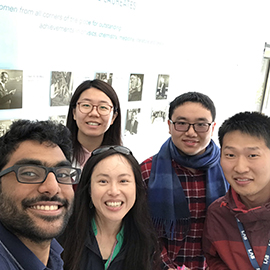 This summer, I did a 10-week internship under Sherry Xiaoye Li in the Scalable Solvers group at Lawrence Berkeley National Laboratory. My internship was funded through the NSF Mathematical Sciences Graduate Internship program. During my 10-week immersion as a member of Sherry’s research group, I saw first-hand what it is like to work on mathematics research outside of an academic setting through my applied research project at the intersection of numerical linear algebra, high-performance computing, and computational quantum chemistry.
This summer, I did a 10-week internship under Sherry Xiaoye Li in the Scalable Solvers group at Lawrence Berkeley National Laboratory. My internship was funded through the NSF Mathematical Sciences Graduate Internship program. During my 10-week immersion as a member of Sherry’s research group, I saw first-hand what it is like to work on mathematics research outside of an academic setting through my applied research project at the intersection of numerical linear algebra, high-performance computing, and computational quantum chemistry.
I’ve also been working as a volunteer Program Coordinator for the Data Scientists in Training Program at NC State. Led by Dr. Eric C. Chi and Dr. Ana-Maria Staicu, we started the inaugural year of the program this summer with a week-long summer boot camp designed to introduce local high school students to fundamentals of statistics and data science, and potential careers in data science.
Finally, I also participated in a week-long workshop for women researchers at the ICERM Women in Data Science and Mathematics (WiSDM) 2019 at Brown. Led by Andrea Bertozzi from UCLA Mathematics, and Yifei Lou from UT Dallas Mathematics, my group started and worked on a hyperspectral imaging problem that week. Now that the workshop is over, we are still working on our project together and have plans to submit our work to an IEEE conference later this summer.
George Elvin
Associate Professor
School of Architecture, College of Design
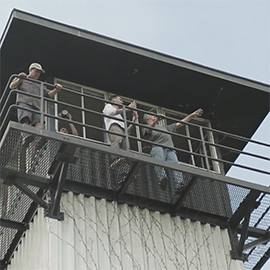 This summer, I submitted a proposal to the Fairfax County (Virginia) Board of Supervisors for a $4 million dollar Geoglyph Skatepark and Adventure Garden for the site of the former Lorton Federal Penitentiary in Virginia. Along with two partners, I targeted the prison’s 75-year-old sewage treatment plant for transformation into a dynamic recreation destination incorporating a pump track course for skateboards and bikes, an adventure play rain garden, a public café, and multipurpose outdoor spaces for community art, music and events. My research assistant and NC State architecture undergraduate Sophia Li contributed her graphic design skills to the 28-page proposal now under review by the Board and the Workhouse Arts Foundation, which now manages the site, for advancement to the next stage of planning and development. In the photo, I am surveying the site of the proposed Geoglyph Skatepark and Adventure Garden from the guard tower of the former prison.
This summer, I submitted a proposal to the Fairfax County (Virginia) Board of Supervisors for a $4 million dollar Geoglyph Skatepark and Adventure Garden for the site of the former Lorton Federal Penitentiary in Virginia. Along with two partners, I targeted the prison’s 75-year-old sewage treatment plant for transformation into a dynamic recreation destination incorporating a pump track course for skateboards and bikes, an adventure play rain garden, a public café, and multipurpose outdoor spaces for community art, music and events. My research assistant and NC State architecture undergraduate Sophia Li contributed her graphic design skills to the 28-page proposal now under review by the Board and the Workhouse Arts Foundation, which now manages the site, for advancement to the next stage of planning and development. In the photo, I am surveying the site of the proposed Geoglyph Skatepark and Adventure Garden from the guard tower of the former prison.
Sujit Ghosh
Professor
Department of Statistics, College of Sciences
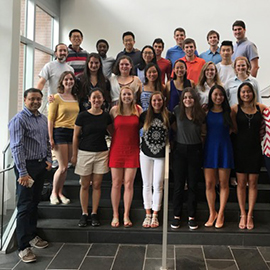 From June 10 to July 19, I, along with my colleague Herle McGowan (Co-PI), and Megan Neely, a faculty member at Duke University, directed the Summer Institute in Biostatistics (SIBS) program. SIBS brings 20 talented undergraduates from across the U.S. to NC State to learn about the exciting field of biostatistics, which involves statistics and data science focused on health sciences research. Our SIBS program, which is now in its fifteenth year and was previously directed by my colleague Marie Davidian, is joint with the Duke University Department of Biostatistics and Bioinformatics and Duke Clinical Research Institute and has been supported since 2004 by a series of grants from the National Heart, Lung, and Blood Institute (NHLBI) of the NIH.
From June 10 to July 19, I, along with my colleague Herle McGowan (Co-PI), and Megan Neely, a faculty member at Duke University, directed the Summer Institute in Biostatistics (SIBS) program. SIBS brings 20 talented undergraduates from across the U.S. to NC State to learn about the exciting field of biostatistics, which involves statistics and data science focused on health sciences research. Our SIBS program, which is now in its fifteenth year and was previously directed by my colleague Marie Davidian, is joint with the Duke University Department of Biostatistics and Bioinformatics and Duke Clinical Research Institute and has been supported since 2004 by a series of grants from the National Heart, Lung, and Blood Institute (NHLBI) of the NIH.
SIBS is meant to encourage participants to pursue graduate (especially Ph.D.) training in statistics/biostatistics; in fact, numerous SIBS alumni have gone on to join our NC State Ph.D. program and are now working as biostatisticians in academia, industry, and government. Over the six weeks, we exposed our participants to principles of statistics and data science and major data analytic challenges in the health sciences, such as working with electronic health records, precision medicine, and more, through lectures and hands-on data analysis labs at both NC State and Duke, a capstone data “hackathon”; and site visits to SAS, Rho Inc, and Duke’s NeuroLab.
One of this summer’s program participants commented, “I learned so much and I think I’m closer to my career goals thanks to the program.” Another participant from last year commented “What I really appreciated about the program is how organized everything was, and how everything had a purpose…In addition to all that I have learned, I also appreciate the friendships that I made during the program.”
We are looking forward to continuing to host SIBS in the summers of 2020-2022 supported by our latest grant, which started August 1! Learn more about our SIBS program.
David Herpy
NC 4-H Camping Specialist
4-H Youth Development and Family and Consumer Sciences, NC State Extension
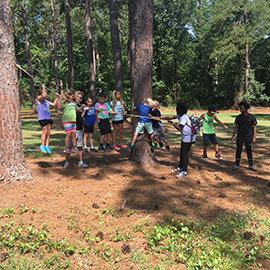 This year, the State 4-H Camping Office received a $60,000 grant through National 4-H Council, titled “Capital and Access to Maximize Participation (CAMP)”, to provide camp scholarships and infrastructure repairs at one of our camps. The grant is two parts. The first is a Capital subgrant, with $25,000 being awarded to replace the cabin windows at our Betsy-Jeff 4-H Educational Center, which opened in 1964 and serves over 6,000 youth annually through summer camp programs and outdoor education programs during the school year.
This year, the State 4-H Camping Office received a $60,000 grant through National 4-H Council, titled “Capital and Access to Maximize Participation (CAMP)”, to provide camp scholarships and infrastructure repairs at one of our camps. The grant is two parts. The first is a Capital subgrant, with $25,000 being awarded to replace the cabin windows at our Betsy-Jeff 4-H Educational Center, which opened in 1964 and serves over 6,000 youth annually through summer camp programs and outdoor education programs during the school year.
The second is an Access subgrant, with $35,000 being awarded to provide camp scholarships, or “camperships,” to youth from vulnerable populations to attend 4-H camp for the first time. With our funding, over 180 youth from vulnerable populations across the state will attend camp for the first time at one of our three NC 4-H Camps this summer. In addition, a small portion of the funding was used to provide supplies and transportation to campers in need, to ensure the same camp experience as other campers with the necessary resources to attend camp. With our dollar for dollar matching funding, all together this is a total investment of $120,000 in our North Carolina 4-H Camps and Centers. We are excited and honored to be able to provide this opportunity this summer for youth from vulnerable populations across our state!
George Hess
Professor
Department of Forestry and Environmental Resources, College of Natural Resources
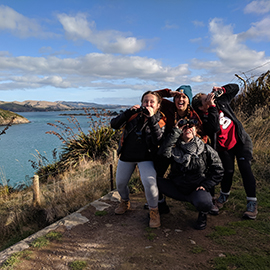 This summer, I co-led a group of 13 NC State students and nine from the University of Florida on a study abroad course to New Zealand. The focus was on sustaining human culture and natural environments in the face of increasing populations, growing tourism, and a plethora of invasive plants and animals that have been displacing native species. We saw extensive work being done to combat invasive species, including removing them from islands, fencing large areas of land to exclude invasive mammalian predators, and — something we did in collaboration with New Zealand’s Department of Conservation — removing invasive plants by hand. We struggled with questions about balancing the benefits of bringing people into the natural environment with the potential for damaging the natural places people love most. We learned that there are ways to sustain a balance, but within limits. Not everyone can swim with dolphins, as we did; the challenges are determining how many people can and how equitable decisions about who gets to have such experiences are made. In the photo, NC State students are looking for albatross at the Royal Albatross Centre on the Otago Peninsula, New Zealand.
This summer, I co-led a group of 13 NC State students and nine from the University of Florida on a study abroad course to New Zealand. The focus was on sustaining human culture and natural environments in the face of increasing populations, growing tourism, and a plethora of invasive plants and animals that have been displacing native species. We saw extensive work being done to combat invasive species, including removing them from islands, fencing large areas of land to exclude invasive mammalian predators, and — something we did in collaboration with New Zealand’s Department of Conservation — removing invasive plants by hand. We struggled with questions about balancing the benefits of bringing people into the natural environment with the potential for damaging the natural places people love most. We learned that there are ways to sustain a balance, but within limits. Not everyone can swim with dolphins, as we did; the challenges are determining how many people can and how equitable decisions about who gets to have such experiences are made. In the photo, NC State students are looking for albatross at the Royal Albatross Centre on the Otago Peninsula, New Zealand.
Katie Homar
Director of International Engineering Writing Support
Graduate School
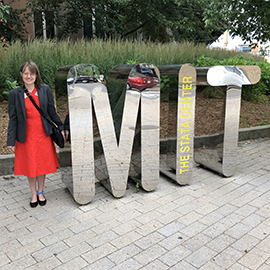 Last year I joined NC State as the Director of Engineering Writing Support on the Graduate School’s Professional Development Team. This summer, I participated in the Massachusetts Institute of Technology’s Engineering CommLab Summer Institute. At this interactive conference, I collaborated with writing professionals from across the country to explore best practices of writing support for STEM graduate students and professional development modeled on MIT’s CommLab program. After this summer event, I am eager to explore implementing some of these practices with the engineering graduate Wolfpack, building on the Graduate School’s robust professional development offerings.
Last year I joined NC State as the Director of Engineering Writing Support on the Graduate School’s Professional Development Team. This summer, I participated in the Massachusetts Institute of Technology’s Engineering CommLab Summer Institute. At this interactive conference, I collaborated with writing professionals from across the country to explore best practices of writing support for STEM graduate students and professional development modeled on MIT’s CommLab program. After this summer event, I am eager to explore implementing some of these practices with the engineering graduate Wolfpack, building on the Graduate School’s robust professional development offerings.
Jessica Katz Jameson
Professor and Department Head
Department of Communication, College of Humanities and Social Sciences
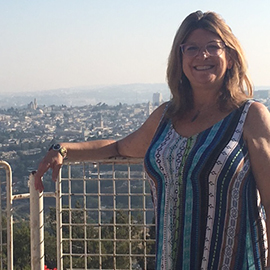
I was honored to be a recipient of the Lady Davis Fellowship to spend two months at Hebrew University (HU) in Jerusalem, Israel. The Lady Davis Fellowship Trust was created in 1973 with a goal of bringing faculty and graduate students from all over the world to study in Israel. During May and June of 2019, I spent time with faculty and students in the Department of Communication and the Swiss Center for Conflict Research, Management, and Resolution. I delivered two lectures, one to the department titled “A retrospective on Jameson and Entman’s ‘Journalism in the democratic management of policy conflict’ (2004): Does increased citizen participation make a difference?” and one to the Swiss Center titled “Developing the LEARN model to promote a supportive conflict communication environment.” My many conversations with faculty and students at HU on conflict and social media resulted in a co-authored paper titled “The normalization of hatred: Social media as a platform for affective polarization in intractable conflict,” currently under review at the journal Social Media + Society. I made wonderful connections and hope to continue the relationship with HU by continuing to collaborate on research and perhaps bringing NC State students to the university in the future.
Roland Kays
Research Professor
Department of Forestry and Environmental Resources, College of Natural Resources
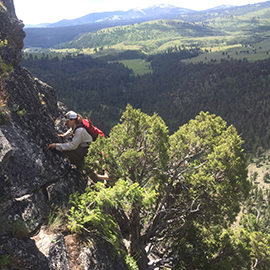 This summer I have been setting camera traps at different sites across the country, including Kansas, Colorado, and Yellowstone National Park, to survey wildlife. This is part of a National Science Foundation-funded project to evaluate relationships between the fruits and seeds produced by trees (i.e. mammal food) and the animal communities they support. Over two years we will be visiting 15 sites that are part of NEON, the National Ecological Observatory Network. Our camera trap pictures will supplement other data already collected by NEON on birds, small mammals, and tree communities. At each site, we set 50 camera traps at ‘random’ points, which sometimes requires a breezy hike through a field, but other times have you scaling cliffs or fighting through thickets.
This summer I have been setting camera traps at different sites across the country, including Kansas, Colorado, and Yellowstone National Park, to survey wildlife. This is part of a National Science Foundation-funded project to evaluate relationships between the fruits and seeds produced by trees (i.e. mammal food) and the animal communities they support. Over two years we will be visiting 15 sites that are part of NEON, the National Ecological Observatory Network. Our camera trap pictures will supplement other data already collected by NEON on birds, small mammals, and tree communities. At each site, we set 50 camera traps at ‘random’ points, which sometimes requires a breezy hike through a field, but other times have you scaling cliffs or fighting through thickets.
James Kiwanuka-Tondo
Associate Professor and Director of Graduate Programs
Department of Communication, College of Humanities and Social Sciences
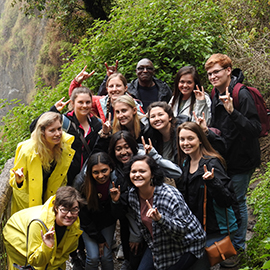 I directed a one-month study abroad program to Botswana this summer. This was my fourth summer program to Botswana since 2011. The program focuses on public health and intercultural communication and involves two courses worth six credits – International Health Issues (COM 498/598/798) and Cross-Cultural Communication (COM 392/523/798). In addition to holding classes, taught by faculty at the University of Botswana, Gaborone, and myself, the program also involves visiting a cultural village where we immerse in Botswana culture.
I directed a one-month study abroad program to Botswana this summer. This was my fourth summer program to Botswana since 2011. The program focuses on public health and intercultural communication and involves two courses worth six credits – International Health Issues (COM 498/598/798) and Cross-Cultural Communication (COM 392/523/798). In addition to holding classes, taught by faculty at the University of Botswana, Gaborone, and myself, the program also involves visiting a cultural village where we immerse in Botswana culture.
Furthermore, it involves service-learning activities during which we visit an HIV/AIDS orphanage and a marginalized tribe that lives in Chobe Game Park known as Khwai Community.
The climax of the program is the visit to Victoria Falls on the border of Zimbabwe and Zambia, which is one of the Seven Wonders of the World. It was such a marvel to witness two of our students do a swing and seven others do a zip line across the falls. What I enjoy most about this program is when students tell me that this program “changed my life” or it “helped me to get out of my comfort zone” or it made me “learn to keep African time and go with the flow” as many of the students said. This is the essence of studying abroad.
Tsai Lu Liu
Professor, Department Head
Department of Graphic Design and Industrial Design, College of Design
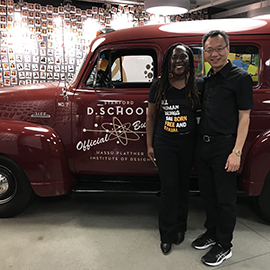 I visited Lesley-Ann Noel, a teaching fellow of Stanford University’s d.school, on June 12. Lesley-Ann received her Ph.D. in design from NC State’s College of Design. I was very proud to be the major professor of her doctoral study. She received tremendous compliments from her colleagues and students at d.school. Lesley-Ann has completed her teaching assignments at Stanford and will start working as a professor of practice at Tulane University’s Phyllis Taylor Center for Social Innovation and Design Thinking in fall 2019.
I visited Lesley-Ann Noel, a teaching fellow of Stanford University’s d.school, on June 12. Lesley-Ann received her Ph.D. in design from NC State’s College of Design. I was very proud to be the major professor of her doctoral study. She received tremendous compliments from her colleagues and students at d.school. Lesley-Ann has completed her teaching assignments at Stanford and will start working as a professor of practice at Tulane University’s Phyllis Taylor Center for Social Innovation and Design Thinking in fall 2019.
Vicki Martin
Professor, Department of Biological Sciences, College of Sciences
Assistant Director, Academic Programs, College of Agriculture and Life Sciences
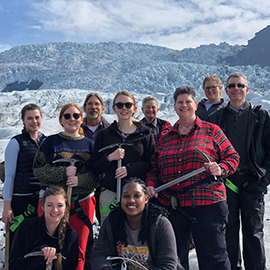 A group of Thomas Jefferson Scholars and faculty from the College of Agriculture and Life Sciences and the College of Humanities and Social Sciences ventured to Iceland, the land of fire and ice, for two weeks in May. The group visited geothermal greenhouses, an Icelandic horse stable, the Agricultural University of Iceland, the Botanical Gardens of Iceland, and descended into an underground lava cave. Highlights of the trip included walking on a glacier in Skaftafell Vatnajokull National Park, maneuvering a duck boat in Jokulsarlon Glacier Lagoon, hiking on black sand beaches littered with ice, traveling to the far north to see the Arctic Circle, and exploring the Ring Road adorned with majestic waterfalls, herds of reindeer, tectonic plates, stunning fjords, geothermal pools and mud pots. Each year the rising Thomas Jefferson Scholars senior class selects an international destination to explore in May. Iceland was mesmerizing!
A group of Thomas Jefferson Scholars and faculty from the College of Agriculture and Life Sciences and the College of Humanities and Social Sciences ventured to Iceland, the land of fire and ice, for two weeks in May. The group visited geothermal greenhouses, an Icelandic horse stable, the Agricultural University of Iceland, the Botanical Gardens of Iceland, and descended into an underground lava cave. Highlights of the trip included walking on a glacier in Skaftafell Vatnajokull National Park, maneuvering a duck boat in Jokulsarlon Glacier Lagoon, hiking on black sand beaches littered with ice, traveling to the far north to see the Arctic Circle, and exploring the Ring Road adorned with majestic waterfalls, herds of reindeer, tectonic plates, stunning fjords, geothermal pools and mud pots. Each year the rising Thomas Jefferson Scholars senior class selects an international destination to explore in May. Iceland was mesmerizing!
Mark Megalos
Extension Professor
Department of Forestry and Environmental Resources, College of Natural Resources/NC State Extension
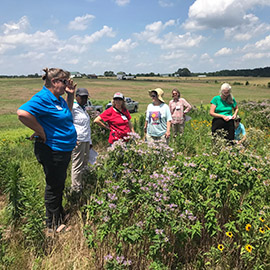 This summer, we are preparing for a series of women-tailored workshops entitled ForestHer. Women landowners and natural resource professionals interested in learning more about management and conservation of private lands are invited to attend one of three ForestHer NC workshops, which will be held across the state in August. During the workshops, participants will learn about North Carolina’s forest ecosystems; identify the types of forests they own and/or manage; and understand the role their woodland plays in the greater landscape. Other topics include defining and balancing multiple land management objectives, obtaining a forest management plan, reading aerial photographs and topo maps, and identifying resources available locally to help with land management. These three events in August are the first in a series of quarterly workshops offered regionally.
This summer, we are preparing for a series of women-tailored workshops entitled ForestHer. Women landowners and natural resource professionals interested in learning more about management and conservation of private lands are invited to attend one of three ForestHer NC workshops, which will be held across the state in August. During the workshops, participants will learn about North Carolina’s forest ecosystems; identify the types of forests they own and/or manage; and understand the role their woodland plays in the greater landscape. Other topics include defining and balancing multiple land management objectives, obtaining a forest management plan, reading aerial photographs and topo maps, and identifying resources available locally to help with land management. These three events in August are the first in a series of quarterly workshops offered regionally.
ForestHer NC is a new initiative created by conservation organizations in North Carolina to provide women who are forest landowners with tools and training to help them manage their lands and become more engaged in forest stewardship. Partners for these workshops are U.S Forest Service, N.C. Tree Farm Program, N.C. Forest Service, Audubon North Carolina, Wild Turkey Federation, N.C. State Extension, and the Sustainable Forestry and Land Retention Project, and the NC Wildlife Resources Commission.
Rupert Nacoste
Alumni Distinguished Undergraduate Professor
Department of Psychology, College of Humanities and Social Sciences
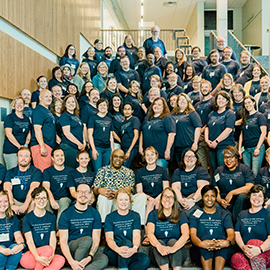 Neo-diversity in Appalachia?
Neo-diversity in Appalachia?
Since 2006 I have been saying, lecturing, writing essays and books to herald that America is in the midst of a struggle with its neo-diversity. All across America people are trying to understand and manage neo-diversity; this new interpersonal situation in which we all have to encounter and sometimes interact with people who do not look like, sound like, worship like or love like, “us.” There has been no better confirmation of that for me than my being invited and hired to be the lead instructor for the Appalachian College Association 2019 Summer Teaching and Leadership Institute, June 3-7.
When I got the first email, I had never heard of the Appalachian College Association. I found out that, “The Appalachian College Association is a non-profit consortium of 35 private four-year liberal arts institutions located in the central Appalachian Mountains in Kentucky, North Carolina, Tennessee, Virginia, and West Virginia.” Why did the Association want me to lead the institute? Well, it turns out that the theme for the institute was “Diversity and Engaged Teaching.” Having learned about the content of one of my books, and my reputation as a classroom professor, the organizers were especially interested in my work on neo-diversity in the classroom and on college campuses.
You see, those small (900 to 1,000 student) campuses were beginning to realize that in every classroom there are people with different group identities whether those identities could be seen or not. They realized that the effectiveness of their teaching was being diminished when they did not take that mix into account in their classrooms. My job was to lay out strategies for their neo-diverse classroom teaching. I spent a week at Emory and Henry College in Emory, Virginia, leading college professors through teaching workshops and workshops on facilitating difficult conversations. Participants’ responses to my teaching leadership were positive and powerful.
I went from thinking that this would be “interesting” to feeling truly excited. I began to realize that with a group of college professors from 15 or so different Appalachian institutions, the experience of learning about and being engaged about neo-diversity would now be rippling out into the whole of the Appalachian College Association campuses. I had a really good time with this group of college professors who teach in Appalachia.
Melissa Pasquinelli
Associate Dean for Academic Affairs
College of Natural Resources
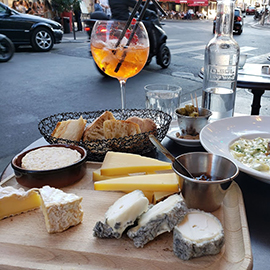 This summer, I had the opportunity to serve as a Young Observer for the International Union of Pure and Applied Chemistry (IUPAC), which sets international standards for the chemical community. As part of that, I went to Paris in July to attend the General Assembly, which is the chemistry version of the United Nations, and observed the delegates discussing and voting on several scientific matters. In addition, I attended committee meetings on green chemistry, materials chemistry, polymer chemistry, and nomenclature in polymer modeling. I also had the opportunity to give a technical talk on the work that my graduate student, Radhika Vaid, has been doing on elucidating the pH effects on the degradation of polyester polymer fibers. This year was an exciting time to participate in IUPAC, as it is its 100 year anniversary, and it is also the 150th anniversary of the periodic table, and so both were celebrated at the event. My favorite display was of all of the elements of the periodic table! I also enjoyed connecting with other chemists from around the world while doing some sightseeing and eating excellent food.
This summer, I had the opportunity to serve as a Young Observer for the International Union of Pure and Applied Chemistry (IUPAC), which sets international standards for the chemical community. As part of that, I went to Paris in July to attend the General Assembly, which is the chemistry version of the United Nations, and observed the delegates discussing and voting on several scientific matters. In addition, I attended committee meetings on green chemistry, materials chemistry, polymer chemistry, and nomenclature in polymer modeling. I also had the opportunity to give a technical talk on the work that my graduate student, Radhika Vaid, has been doing on elucidating the pH effects on the degradation of polyester polymer fibers. This year was an exciting time to participate in IUPAC, as it is its 100 year anniversary, and it is also the 150th anniversary of the periodic table, and so both were celebrated at the event. My favorite display was of all of the elements of the periodic table! I also enjoyed connecting with other chemists from around the world while doing some sightseeing and eating excellent food.
Seema Sheth
Assistant Professor
Department of Plant and Microbial Biology, College of Agriculture and Life Sciences
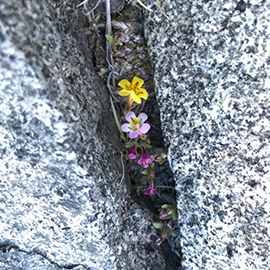 I spent a week in the White Mountains of eastern California as part of a broad, collaborative international effort to study the effects of climate change on alpine plants. Mountain tops, which are particularly sensitive to rising temperatures, are ideal places to examine how plant communities are responding to a changing climate. Further, if plant species are shifting upslope to track cooler temperatures, then the abundance of species adapted to warmer climates may increase over time on mountain tops. In 2001, the Global Observation Research Initiative in Alpine Environments (GLORIA) was founded to develop international collaboration and cost-effective protocol for consistently assessing the effects of climate change on alpine plants worldwide. Through these efforts, over 100 monitoring sites have been set up, spanning every continent except for Antarctica.
I spent a week in the White Mountains of eastern California as part of a broad, collaborative international effort to study the effects of climate change on alpine plants. Mountain tops, which are particularly sensitive to rising temperatures, are ideal places to examine how plant communities are responding to a changing climate. Further, if plant species are shifting upslope to track cooler temperatures, then the abundance of species adapted to warmer climates may increase over time on mountain tops. In 2001, the Global Observation Research Initiative in Alpine Environments (GLORIA) was founded to develop international collaboration and cost-effective protocol for consistently assessing the effects of climate change on alpine plants worldwide. Through these efforts, over 100 monitoring sites have been set up, spanning every continent except for Antarctica.
I recently became the Science Director of the non-profit organization GLORIA Great Basin, which supports these efforts in the Great Basin regions of eastern California and Nevada. GLORIA Great Basin resurveys each of 29 mountain peaks in eight target regions, including Death Valley National Park, Great Basin National Park and the Sierra Nevada Mountains of California, on a rotating basis every five years. During these surveys, a diverse and interdisciplinary group of citizen scientists, students, postdocs, professors, and federal land agency botanists and ecologists from all walks of life work together to collect data on the presence and abundance of alpine plants. These data will foster international collaborations to understand how alpine plants are responding to climate change within a single mountain range, across a continent, and eventually across the entire globe. If you would like to learn more about this work or contribute to Gloria Great Basin’s efforts, please visit www.gloriagreatbasin.org.
Janice Sitzes
Associate Director, Marketing Services
Continuing and Professional Education
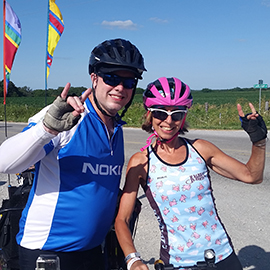 This summer, I participated in RAGBRAI XLVI — the Register’s Annual Great Bicycle Ride Across Iowa. This was my 11th consecutive summer participating in this event, which takes place during the last full week of July. The route changes every year, but always goes west to east. Riders start the week by dipping their rear wheels in the Missouri River and finish the week by dipping their front wheels in the Mississippi River. This year’s ride was a southern route, starting in Council Bluffs and finishing in Keokuk, with overnight stops in Atlantic, Winterset, Indianola, Centerville, Fairfield, and Burlington. We covered 480 miles — our lowest mileage day was 45 miles; our highest mileage day was 90 miles. For the people of the pass-through and overnight towns, RAGBRAI is a huge economic boost, with 10,000+ cyclists buying their food along the way (especially homemade pie, for which the ride is “famous”). Local groups have used food sales to fund a new community playground, buy band uniforms, install a new roof on their church, and purchase life-saving equipment, among many other noteworthy causes. The people, and the opportunity to see and experience this part of the country, make this an unforgettable adventure.
This summer, I participated in RAGBRAI XLVI — the Register’s Annual Great Bicycle Ride Across Iowa. This was my 11th consecutive summer participating in this event, which takes place during the last full week of July. The route changes every year, but always goes west to east. Riders start the week by dipping their rear wheels in the Missouri River and finish the week by dipping their front wheels in the Mississippi River. This year’s ride was a southern route, starting in Council Bluffs and finishing in Keokuk, with overnight stops in Atlantic, Winterset, Indianola, Centerville, Fairfield, and Burlington. We covered 480 miles — our lowest mileage day was 45 miles; our highest mileage day was 90 miles. For the people of the pass-through and overnight towns, RAGBRAI is a huge economic boost, with 10,000+ cyclists buying their food along the way (especially homemade pie, for which the ride is “famous”). Local groups have used food sales to fund a new community playground, buy band uniforms, install a new roof on their church, and purchase life-saving equipment, among many other noteworthy causes. The people, and the opportunity to see and experience this part of the country, make this an unforgettable adventure.
Cara Smelter
University Program Associate
Interdisciplinary Studies and International Programs, College of Humanities and Social Sciences
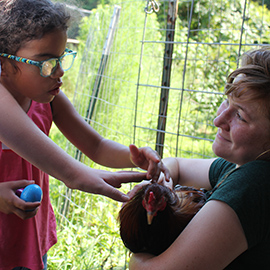 I began serving as a volunteer for Piedmont Farm Animal Refuge (The Refuge), a 501-c3 non-profit organization that provides lifelong sanctuary to abused, neglected, and abandoned farmed animals, in the summer of 2015. Since 2016, The Refuge has offered a week-long summer camp, Camp Compassion, for children ages 7–12. Camp Compassion provides the opportunity for children to interact with, and help care for the residents of The Refuge, including- goats, sheep, turkeys, chickens, and ducks, and learn the foundations of how to prepare healthy plant-based meals. Since its inception, I have had the privilege of volunteering to either serve as a counselor or help with the preparation for Camp Compassion. This year, the week of July 15–July 19, I returned to Camp Compassion as a counselor.
I began serving as a volunteer for Piedmont Farm Animal Refuge (The Refuge), a 501-c3 non-profit organization that provides lifelong sanctuary to abused, neglected, and abandoned farmed animals, in the summer of 2015. Since 2016, The Refuge has offered a week-long summer camp, Camp Compassion, for children ages 7–12. Camp Compassion provides the opportunity for children to interact with, and help care for the residents of The Refuge, including- goats, sheep, turkeys, chickens, and ducks, and learn the foundations of how to prepare healthy plant-based meals. Since its inception, I have had the privilege of volunteering to either serve as a counselor or help with the preparation for Camp Compassion. This year, the week of July 15–July 19, I returned to Camp Compassion as a counselor.
Each day the campers provided animal care and created enrichment activities for the residents- from cleaning the water dishes and preparing breakfast for the turkeys and chickens, to building beautiful fruit cakes made of thick and juicy watermelon cylinders topped with strawberries, kiwi, blueberries and bananas as enrichment for the sheep. Campers learned the stories of the residents — tales of courage, resilience, and compassion — and found that the farmed animals they cared for were not so dissimilar from themselves and the people in their life that they love.
In addition to animal care and enrichment, campers enjoyed a variety of activities ranging from animal science and cooking science to artistic expression. This year on goat day, The Refuge’s ruminants’ vet, Dr. Swink, taught a lesson and had the campers help her give a full “check-up” of a few of the goat residents — letting the campers listen to digestion, heartbeats, and having the campers check for healthy hooves. Each day, the campers learned a new food science lesson and made their plant-based lunch, including delicious hand-made pizza to pickled carrots and banh mis. Creativity and artistic expression is an anchor of Camp Compassion and camp this year offered a creative writing workshop, improv, collaging and shirt making.
Camp Compassion is a uniquely special opportunity for kids to interface with farmed animals. It provides children and, in turn, their families the opportunity to learn the stories of the residents and consider the sentience of these very special beings. Moreover, this camp teaches children to cultivate valuable emotional intelligence and compassionate behaviors at camp and beyond.
Hiller Spires
Alumni Distinguished Graduate Professor
Friday Institute for Educational Innovation, College of Education
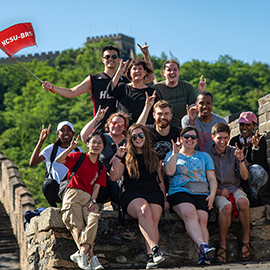 I have been to China more than a dozen times, but was able to get a new perspective on the country this spring. I led my first study abroad course in May, taking 11 students to three cities for “Exploring Culture and Education in China.” The students spent two weeks visiting Shanghai, Suzhou and Beijing, embracing the local culture and observing and co-teaching lessons. The students visited two Chinese schools we have built strong relationships with over the past decade. In 2010, we created a partnership with the Beijing Royal School, which has welcomed student teachers from NC State and sent 24 of their own teachers to the College of Education to receive their master’s of education degree through the New Literacies and Global Learning Program. In 2013, I helped create Suzhou North American High School, which collaborates with educators in North Carolina. In addition to many cultural events, the NC State students were able to observe classes at both schools and co-taught classes with partner teachers. Traveling to another country is always mind-expanding. China, with its high context culture, always offers something new.
I have been to China more than a dozen times, but was able to get a new perspective on the country this spring. I led my first study abroad course in May, taking 11 students to three cities for “Exploring Culture and Education in China.” The students spent two weeks visiting Shanghai, Suzhou and Beijing, embracing the local culture and observing and co-teaching lessons. The students visited two Chinese schools we have built strong relationships with over the past decade. In 2010, we created a partnership with the Beijing Royal School, which has welcomed student teachers from NC State and sent 24 of their own teachers to the College of Education to receive their master’s of education degree through the New Literacies and Global Learning Program. In 2013, I helped create Suzhou North American High School, which collaborates with educators in North Carolina. In addition to many cultural events, the NC State students were able to observe classes at both schools and co-taught classes with partner teachers. Traveling to another country is always mind-expanding. China, with its high context culture, always offers something new.
Julie Swann
Doug Allison Distinguished Professor and Department Head
Edward P. Fitts Department of Industrial and Systems Engineering, College of Engineering
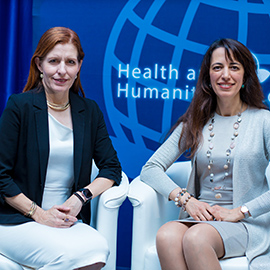 I traveled to Kigali, Rwanda this summer, as a co-organizer of the annual Health and Humanitarian Logistics Conference. This is the 11th year of the event, which brings together academia, government, non-governmental organizations, and companies, towards solving problems in the global health and humanitarian sector. While in Rwanda I also took one day to see the local attractions, mainly to trek to see mountain gorillas living in their natural habitat. We were quite close to the gorillas, who would also walk right past us.
I traveled to Kigali, Rwanda this summer, as a co-organizer of the annual Health and Humanitarian Logistics Conference. This is the 11th year of the event, which brings together academia, government, non-governmental organizations, and companies, towards solving problems in the global health and humanitarian sector. While in Rwanda I also took one day to see the local attractions, mainly to trek to see mountain gorillas living in their natural habitat. We were quite close to the gorillas, who would also walk right past us.
Courtney Thornton
Associate Vice Provost for Academic Personnel and Policy
Office of the Executive Vice Chancellor and Provost
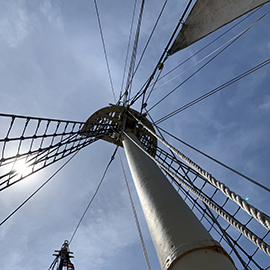 Do you catch yourself whistling “Drunken Sailor” as you walk between meetings? Or daydreaming of life on a whaling ship? Then the annual Sea Music Festival in Connecticut’s Mystic Seaport may be for you. The Festival celebrated its 40th year, and I attended with my daughter and a family friend. The festival begins with a scholarly symposium and ends with a weekend of song-filled events and demonstrations. Along with a few hundred new friends, we sang chanties and were given the chance to heave the capstan round and haul the sails. Guitars and concertinas could be heard at every corner of the Seaport — with sessions on songs about women at sea, sea monsters, disasters and more. It was clearly a tight community of musicians and fans that knew each other well, but we still fit right in and enjoyed the hearty celebration of a life and time gone by. And, of course, now I’m searching for a concertina…much more portable than my accordion.
Do you catch yourself whistling “Drunken Sailor” as you walk between meetings? Or daydreaming of life on a whaling ship? Then the annual Sea Music Festival in Connecticut’s Mystic Seaport may be for you. The Festival celebrated its 40th year, and I attended with my daughter and a family friend. The festival begins with a scholarly symposium and ends with a weekend of song-filled events and demonstrations. Along with a few hundred new friends, we sang chanties and were given the chance to heave the capstan round and haul the sails. Guitars and concertinas could be heard at every corner of the Seaport — with sessions on songs about women at sea, sea monsters, disasters and more. It was clearly a tight community of musicians and fans that knew each other well, but we still fit right in and enjoyed the hearty celebration of a life and time gone by. And, of course, now I’m searching for a concertina…much more portable than my accordion.
Micah Vandergrift
Open Knowledge Librarian
NC State University Libraries
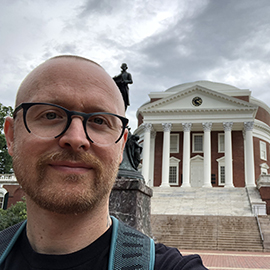 As the Lead Principal Investigator on the Immersive Scholar project funded by the Andrew W. Mellon Foundation, I am exploring questions of how to treat visualization projects as part of the scholarly record. This summer, I attended the Emulation in the Archives workshop at the University of Virginia on July 18 and heard from lawyers, technologists, archivists, and librarians about the challenges of software preservation and some of the advances in the field. I also took a few hours to visit colleagues in the Scholars Lab, one of the nation’s premier experimental scholarship centers.
As the Lead Principal Investigator on the Immersive Scholar project funded by the Andrew W. Mellon Foundation, I am exploring questions of how to treat visualization projects as part of the scholarly record. This summer, I attended the Emulation in the Archives workshop at the University of Virginia on July 18 and heard from lawyers, technologists, archivists, and librarians about the challenges of software preservation and some of the advances in the field. I also took a few hours to visit colleagues in the Scholars Lab, one of the nation’s premier experimental scholarship centers.
My primary takeaway is that effective and robust documentation, from the code to the software to the research processes, is a great first step to prepare for preservation and emulation. As the Immersive Scholar project enters its final year, we will apply ideas from the Digital Documentation Process, the Data Curation Network, and the Software Preservation Network to test the sustainability and reproducibility of our outputs.
Olivia Vilá
Ph.D. Student
Department of Parks, Recreation, and Tourism Management, College of Natural Resources
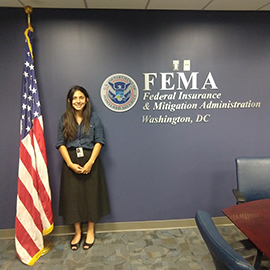 For my summer internship, I was hired by AECOM to support their technical assistance contract for the Federal Emergency Management Agency (FEMA) Hazard Mitigation Assistance division at the FEMA Headquarters in Washington, D.C. As part of this internship, I had the unique opportunity to work with FEMA as they developed their new mitigation grant program “Building Resilient Infrastructure and Communities” (BRIC). My first couple of weeks were a crash-course in FEMA, federal mitigation grants, policy, and acronyms. Alongside the many incredible opportunities to learn, I was able to leverage my skills in qualitative data analysis to contribute to the development of the BRIC program — by managing, analyzing, and reporting on the data resulting from FEMAs extensive stakeholder engagement efforts conducted in relation to the BRIC program. Prior to this internship, I was ignorant of the role a social scientist, a qualitative researcher, or I could play in the development of federal policy and programs. This summer has been critical to my growth as a graduate student and has profoundly influenced my research interests and confidence as a researcher. Thank you AECOM and FEMA for the incredible experience.
For my summer internship, I was hired by AECOM to support their technical assistance contract for the Federal Emergency Management Agency (FEMA) Hazard Mitigation Assistance division at the FEMA Headquarters in Washington, D.C. As part of this internship, I had the unique opportunity to work with FEMA as they developed their new mitigation grant program “Building Resilient Infrastructure and Communities” (BRIC). My first couple of weeks were a crash-course in FEMA, federal mitigation grants, policy, and acronyms. Alongside the many incredible opportunities to learn, I was able to leverage my skills in qualitative data analysis to contribute to the development of the BRIC program — by managing, analyzing, and reporting on the data resulting from FEMAs extensive stakeholder engagement efforts conducted in relation to the BRIC program. Prior to this internship, I was ignorant of the role a social scientist, a qualitative researcher, or I could play in the development of federal policy and programs. This summer has been critical to my growth as a graduate student and has profoundly influenced my research interests and confidence as a researcher. Thank you AECOM and FEMA for the incredible experience.
Lindsay Zanno
Associate Research Professor
Department of Biological Sciences, College of Sciences
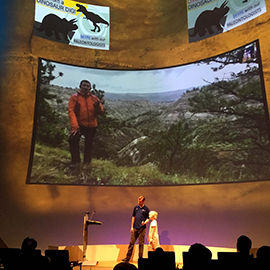 During the summer, the Zanno Lab went out for a 10-week expedition. First stop? The 66 million-year-old Badlands of Montana in the Hell Creek Formation. Here the team searched for the body of the nearly complete Triceratops skull collected last summer, explored a Tyrannosaurus rex locality that turned up a six-inch-long tooth, and collected sediment for a new international citizen science project—Cretaceous Creatures. In July, seven NC State undergrads enrolled in BIO 325, Paleontological Field Methods, joined the team in northwestern New Mexico to collect the remains of new dinosaur, croc, and turtle species.
During the summer, the Zanno Lab went out for a 10-week expedition. First stop? The 66 million-year-old Badlands of Montana in the Hell Creek Formation. Here the team searched for the body of the nearly complete Triceratops skull collected last summer, explored a Tyrannosaurus rex locality that turned up a six-inch-long tooth, and collected sediment for a new international citizen science project—Cretaceous Creatures. In July, seven NC State undergrads enrolled in BIO 325, Paleontological Field Methods, joined the team in northwestern New Mexico to collect the remains of new dinosaur, croc, and turtle species.
In late summer the crew wrapped up the season with a few weeks in the Utah desert scouring the rocks that produced North America’s tiniest tyrannosaur Moros, the megapredator Siats, the first clutch of oviraptorosaur dinosaur eggs on the continent, and many as-of-yet undescribed dinosaurs currently under preparation in the lab. The 2019 expedition team included >30 individuals, including four NC State graduate students, 12 undergraduates from NC State, Duke, and Wake Tech, and 11 volunteers. You can see their exploits and be the first to learn about new discoveries @Expeditionlive or www.expeditionlive.org.
- Categories:
